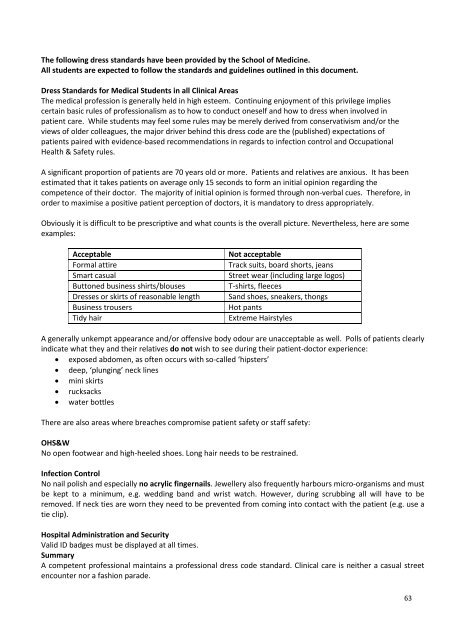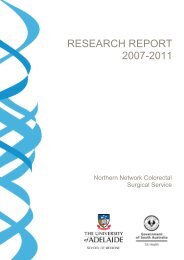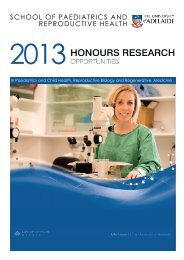Discipline of Rural Health - Faculty of Health Sciences - The ...
Discipline of Rural Health - Faculty of Health Sciences - The ...
Discipline of Rural Health - Faculty of Health Sciences - The ...
You also want an ePaper? Increase the reach of your titles
YUMPU automatically turns print PDFs into web optimized ePapers that Google loves.
<strong>The</strong> following dress standards have been provided by the School <strong>of</strong> Medicine.<br />
All students are expected to follow the standards and guidelines outlined in this document.<br />
Dress Standards for Medical Students in all Clinical Areas<br />
<strong>The</strong> medical pr<strong>of</strong>ession is generally held in high esteem. Continuing enjoyment <strong>of</strong> this privilege implies<br />
certain basic rules <strong>of</strong> pr<strong>of</strong>essionalism as to how to conduct oneself and how to dress when involved in<br />
patient care. While students may feel some rules may be merely derived from conservativism and/or the<br />
views <strong>of</strong> older colleagues, the major driver behind this dress code are the (published) expectations <strong>of</strong><br />
patients paired with evidence-based recommendations in regards to infection control and Occupational<br />
<strong>Health</strong> & Safety rules.<br />
A significant proportion <strong>of</strong> patients are 70 years old or more. Patients and relatives are anxious. It has been<br />
estimated that it takes patients on average only 15 seconds to form an initial opinion regarding the<br />
competence <strong>of</strong> their doctor. <strong>The</strong> majority <strong>of</strong> initial opinion is formed through non-verbal cues. <strong>The</strong>refore, in<br />
order to maximise a positive patient perception <strong>of</strong> doctors, it is mandatory to dress appropriately.<br />
Obviously it is difficult to be prescriptive and what counts is the overall picture. Nevertheless, here are some<br />
examples:<br />
Acceptable Not acceptable<br />
Formal attire Track suits, board shorts, jeans<br />
Smart casual Street wear (including large logos)<br />
Buttoned business shirts/blouses T-shirts, fleeces<br />
Dresses or skirts <strong>of</strong> reasonable length Sand shoes, sneakers, thongs<br />
Business trousers Hot pants<br />
Tidy hair Extreme Hairstyles<br />
A generally unkempt appearance and/or <strong>of</strong>fensive body odour are unacceptable as well. Polls <strong>of</strong> patients clearly<br />
indicate what they and their relatives do not wish to see during their patient-doctor experience:<br />
• exposed abdomen, as <strong>of</strong>ten occurs with so-called ‘hipsters’<br />
• deep, ‘plunging’ neck lines<br />
• mini skirts<br />
• rucksacks<br />
• water bottles<br />
<strong>The</strong>re are also areas where breaches compromise patient safety or staff safety:<br />
OHS&W<br />
No open footwear and high-heeled shoes. Long hair needs to be restrained.<br />
Infection Control<br />
No nail polish and especially no acrylic fingernails. Jewellery also frequently harbours micro-organisms and must<br />
be kept to a minimum, e.g. wedding band and wrist watch. However, during scrubbing all will have to be<br />
removed. If neck ties are worn they need to be prevented from coming into contact with the patient (e.g. use a<br />
tie clip).<br />
Hospital Administration and Security<br />
Valid ID badges must be displayed at all times.<br />
Summary<br />
A competent pr<strong>of</strong>essional maintains a pr<strong>of</strong>essional dress code standard. Clinical care is neither a casual street<br />
encounter nor a fashion parade.<br />
63





